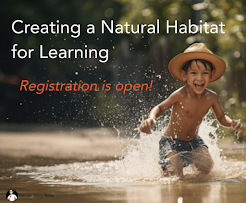Facts are not negotiable; they are the undeniable things that we all have in common.
The sun rises in the east.
Check.
2 + 2 = 4.
Check.
It takes two hydrogen atoms and one oxygen atom to make a water molecule.
Check.
Facts are things we can prove, measure, and test. They are things we
know. And I'm not interested in any freshman year philosophical questions like, "But how do we know that we know?" When the preponderance of evidence is there, we owe it to ourselves, our fellow man, and even our god to behave as if it's true. This is how the species progresses.
This little lecture has been brought to you out of my reaction to reading Deb's terrific post over at
Science@Home explaining in terms understandable to children why daddies tend to be bigger than mummies. Deb is a scientist, educator and mummy, all of which are evident in her clear, concise, fact-based post. It's exactly the kind of explanation that I'd hope my own young child would receive from her science teachers. (I urge you to head on over there and have a look around.)
Sadly, in many parts of the US, the contents of Deb's post, if delivered in a public school classroom, would land her in the principal's office to face angry parents over evoking such scientific consensus as evolution, her matter-of-fact discussion of procreation, and statements like, "we are animals and work on the same rules as the rest of the world." And while there are anti-science zealots everywhere, no other modern nation teeters so close to edge of having it's public science education curriculum fall into the intentional blindness of fundamentalist faith. Polls taken over the course of the last decade, for instance, consistently show that between 25 and 30 percent of Americans believe that "creationism" or the junk science of "intelligent design" should be taught in science class alongside evolution. Really? I do hope that this is just the result of poorly crafted polling questions because otherwise it means that, at minimum, one in every 4 people with whom I come into contact on a daily basis does not understand the difference between science and religion. Or worse, actively seeks to blur the line in the furtherance of his own particular religious or political ends.
It's insane, too, that after writing the above paragraph I must, as a matter of form, quickly and apologetically offer the disclaimer that
I, of course, have nothing against religion. Damn it, I
do have something against any religion whose adherents seek to force its mythologies upon me and my child, be it in the public schools or through laws that serve no purpose other than to enshrine religious intolerance (like banning gay marriage).
If democracy is going to work, we must be able to agree that facts are facts. Other nations seem to understand this. We can and should debate our beliefs in our philosophy and religious studies classes, in our churches and synagogues
, even amongst willing friends and families, but when your beliefs are contradicted by fact as determined through the rigors of the scientific method and the weight of academic consensus, you don't get to insist that we change those facts to suit your illogical, however spiritually gratifying, belief. Period.
Our public schools have wavered, but so far the courts of both law and public opinion have compelled them back onto the path of democracy. It's crazy that we must constantly defend our educational system like this, always fighting back those who would have us return to the dark times when religious leaders, not scientists, commanded that the Earth was the center of the universe, that disease was caused by sin, and that cats are in league with satan.
I've often written here about my conviction that the purpose of public schools in America is to educate children so that they can function as citizens in a democracy, while expressing concern about the vocationalization of our curricula. While I find many points at which these two purposes are at odds, one point upon which they share interests is in children receiving a fact-based science education. I've spent my entire adult life (mostly via my wife) in the company of business executives and business owners, people whose economic success depends upon our public schools producing adults who can think logically and lucidly, who possess a grasp of what is factually knowable about the world. Some of them are religious, some not, some are conservatives, some liberal, but I've never met one who would hire an employee whose understanding of science was based on creation myths.
In a democracy, I get to
believe as my conscience guides me, as does my child, who as a 12-year-old decided to embrace a faith different than my own. If I walk into your church, if I ask you about your faith, then have at me, evangelize away. But when it comes to science classes in our public schools, belief does not trump fact. When it does, we are all lost.
I've had enough experience with this debate in recent years to know that I'm setting myself up for attack. I'll be called an atheist, which I am not. I'll be directed to so-called "peer reviewed" articles that cast doubts on evolution, all of which will be from the Discovery Institute, a "think tank" based here in Seattle, which exists solely for the purpose of muddying the waters around the teaching of evolution. I'll be told that evolution is "just a theory," a position that demonstrates a fundamental misunderstanding of how science works. They will be wrong.
Those are the facts.




















































